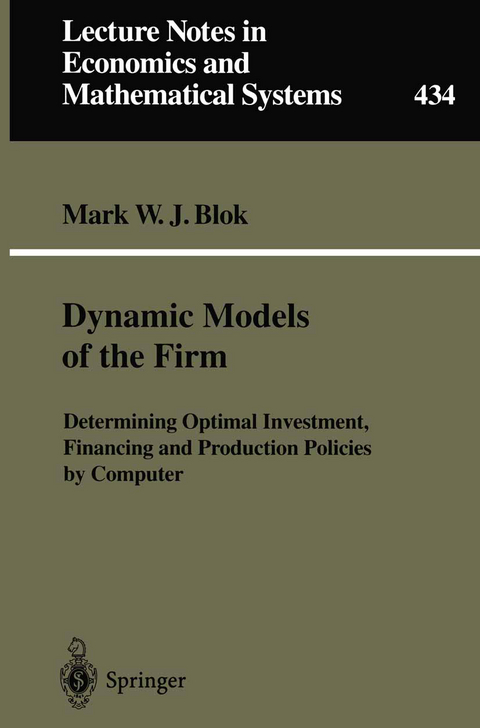
Dynamic Models of the Firm
Springer Berlin (Verlag)
978-3-540-60802-8 (ISBN)
1 Introduction.- 2 Mathematical Background to Dynamic Optimization.- 2.1 Introduction.- 2.2 Analytical approach to the optimization problem.- 2.3 Numerical approach to the optimization problem.- 2.4 Economic interpretation of the adjoint variables.- 2.5 General procedure.- 3 The Basic Model.- 3.1 Introduction.- 3.2 The model and its assumptions.- 3.3 Examination of the paths.- 3.4 Case study.- 3.5 Conclusions.- 4 A Model with Start-up Costs.- 4.1 Introduction.- 4.2 The model and its assumptions.- 4.3 Examination of the paths.- 4.4 Case study.- 4.5 Conclusions.- 5 Models with a Business Cycle.- 5.1 Introduction.- 5.2 The basic model.- 5.3 A model with a variable utilization rate.- 5.4 A model with a cash balance.- 5.5 A model with an inventory of finished goods.- 5.6 Conclusions.- 6 A Model with Increasing Returns to Scale, an Experience Curve and a Production Life Cycle.- 6.1 Introduction.- 6.2 Description of the model.- 6.3 Case study.- 6.4 Conclusions.- Appendices.- A Mathematical Details for Chapter 3.- A.1 Problem formulation.- A.2 Necessary conditions for optimality.- A.3 Elaborating the transversality conditions.- A.4 Further examination of some paths.- B Mathematical Details for Chapter 4.- B.1 Problem formulation.- B.2 Necessary conditions for optimality.- B.3 Elaborating the transversality conditions.- B.4 Further examination of some paths.- C Mathematical Details for Chapter 5.- C.1 The basic model.- C.1.1 Determining the coupling points for Subsection 5.2.2.- C.1.2 Determining the coupling points for Subsection 5.2.3.- C.1.3 Deriving relationships (5.22) and (5.27).- C.1.4 Determining the coupling points for Subsection 5.2.4.- C.l.5 Determining the coupling points for Subsection 5.2.5.- C.1.6 Deriving relationships (5.45) and (5.49).- C.2 A model with a variable utilization rate.- C.2.1 Necessary conditions for optimality.- C.2.2 Further examination of some paths.- C.2.3 Determining the coupling points for Subsection 5.3.2.- C.2.4 Determining the coupling points for Subsection 5.3.3.- C.2.5 Determining the coupling points for Subsection 5.3.4.- C.3 A model with a cash balance.- C.3.1 Necessary conditions for optimality.- C.3.2 Further examination of some paths.- C.3.3 Determining the coupling points for Subsection 5.4.2.- C.3.4 Determining the coupling points for Subsection 5.4.3.- C.3.5 Determining the coupling points for Subsection 5.4.5.- C.4 A model with an inventory of finished goods.- C.4.1 Necessary conditions for optimality.- C.4.2 Further examination of some paths.- C.4.3 Determining the coupling points for Subsection 5.5.2.- C.4.4 Determining the coupling points for Subsection 5.5.3.- D Mathematical Details for Chapter 6.- D.1 Necessary conditions for optimality.- Symbols and Notation.- Summary.
| Erscheint lt. Verlag | 7.3.1996 |
|---|---|
| Reihe/Serie | Lecture Notes in Economics and Mathematical Systems |
| Zusatzinfo | VII, 193 p. |
| Verlagsort | Berlin |
| Sprache | englisch |
| Maße | 155 x 235 mm |
| Gewicht | 323 g |
| Themenwelt | Mathematik / Informatik ► Informatik ► Theorie / Studium |
| Mathematik / Informatik ► Mathematik | |
| Wirtschaft ► Betriebswirtschaft / Management ► Planung / Organisation | |
| Wirtschaft ► Volkswirtschaftslehre ► Mikroökonomie | |
| Schlagworte | Computer • Dynamic Models • Dynamische Modelle • nicht-lineare Optimierungsmethoden • Non-linear Optimization Methods • optimal control theory • Optimierung • Optimization • Production • Simulation |
| ISBN-10 | 3-540-60802-8 / 3540608028 |
| ISBN-13 | 978-3-540-60802-8 / 9783540608028 |
| Zustand | Neuware |
| Haben Sie eine Frage zum Produkt? |
aus dem Bereich


